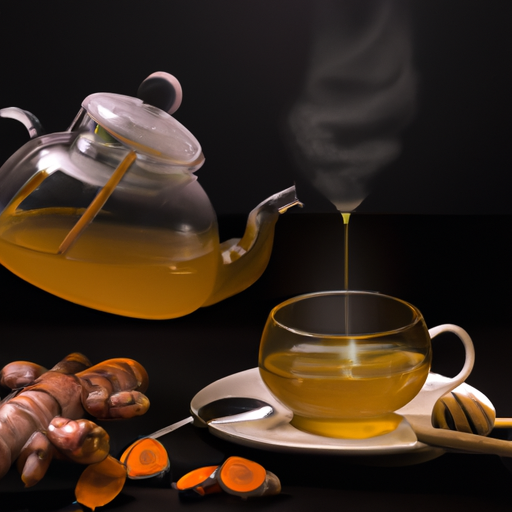As an individual who is deeply interested in natural remedies and holistic health, I have always found the numerous advantages of turmeric to be fascinating. This yellow spice, often found in Indian cooking, has been proven to possess anti-inflammatory properties and potentially improve cognitive abilities.
One popular way to consume turmeric is through turmeric tea, but how much turmeric should you actually be using? In this article, we will explore the factors that affect the amount of turmeric in your cup of tea and how to ensure that you are getting enough to reap its health benefits.
From understanding turmeric concentration to making your own tea at home, we will cover everything you need to know about incorporating this powerful spice into your daily routine. So grab a mug and let’s dive in!
Key Takeaways
- The amount of turmeric in turmeric tea can be affected by various factors, such as adding milk or other substances, and the recommended amount is 1 tsp of grated or ground turmeric per cup of water.
- Black pepper enhances the bioavailability of curcumin in turmeric tea, while incorporating healthy fats such as coconut oil or ghee improves its efficacy in reducing pain and inflammation.
- Turmeric supplements are available in pill or powder form, and the recommended daily intake depends on the form consumed, with up to 8 grams of turmeric per day being safely consumed without adverse effects.
- Reading tea labels is important to ensure high-quality tea with adequate amounts of therapeutic components, and consulting a healthcare provider before making significant changes to diet or supplement routine is recommended.
The Health Benefits of Turmeric Tea
You’re going to love how sipping on a cup of turmeric tea can boost your health and wellbeing! This flavorful tea packs a powerful punch when it comes to reducing inflammation in the body, which is linked to many chronic diseases like arthritis, heart disease, and even cancer.
Turmeric tea recipes often include ginger and black pepper to enhance the bioavailability of curcumin, the active ingredient in turmeric that gives it its anti-inflammatory properties. Turmeric tea has been used for centuries in Ayurvedic medicine as an effective treatment for various ailments.
Drinking this spice-infused beverage regularly may also help reduce pain and stiffness associated with arthritis, improve brain function and memory retention, lower blood sugar levels and cholesterol levels while boosting immunity. So go ahead and try making your own delicious turmeric tea at home today!
Now let’s take a closer look at factors that affect the amount of turmeric in turmeric tea.
Factors that Affect the Amount of Turmeric in Turmeric Tea
There’s a saying that goes ‘a watched pot never boils,’ and similarly, the amount of turmeric in your turmeric tea can be affected by various factors.
Factors affecting turmeric potency include the quality and freshness of the turmeric used, as well as the amount and duration of boiling.
It’s also important to note that adding milk or other substances to your tea can decrease its potency.
Measuring turmeric for tea can be a bit tricky since there is no exact measurement for how much should be added. However, a good rule of thumb is to use 1 teaspoon of grated or ground turmeric per cup of water.
To maximize its health benefits, it’s recommended to add a pinch of black pepper as well, which aids in the absorption of curcumin – an active ingredient in turmeric.
Understanding turmeric concentration can help you make informed decisions about how much you need to consume daily for optimal health benefits.
Understanding Turmeric Concentration
If you want to get the most out of your turmeric, it’s important to understand how concentrated it can be and how much you need for optimal health benefits. Turmeric bioavailability refers to the amount of turmeric that is absorbed by the body and available for use. This varies depending on factors like how it is prepared, what it is consumed with, and individual differences in metabolism.
To achieve the optimal dosage of turmeric in your tea, it’s helpful to know some general guidelines. According to research studies, a daily intake of 500-2,000 mg of curcumin (the active ingredient in turmeric) is considered safe and effective for most people. To put this into perspective, one teaspoon of ground turmeric contains about 200 mg of curcumin. However, due to variations in bioavailability and individual needs, some may require higher or lower doses. It’s always best to consult a healthcare provider before making significant changes to your diet or supplement routine.
When looking at tea labels, keep an eye out for information on the amount of actual turmeric used in each serving as well as any added ingredients that could affect bioavailability. With this knowledge about concentration and dosage in mind, we can move onto understanding how to read tea labels effectively.
Reading Tea Labels
To effectively read tea labels and make informed decisions about your turmeric intake, it’s important to look for specific information such as the amount and quality of added ingredients that may affect bioavailability.
When reading a label, check for the amount of turmeric or curcumin listed per serving. The ideal potency is around 500 milligrams per serving, which can enhance the health benefits associated with turmeric consumption.
Additionally, be mindful of any other ingredients that might impact the effectiveness of your tea. Some manufacturers may add fillers or flavorings that could dilute the concentration of active compounds in turmeric. While certain flavorings like ginger root or black pepper can boost absorption rates, others might have little to no effect on bioavailability.
By learning how to properly read labels, you can ensure you’re getting high-quality tea with adequate amounts of therapeutic components.
As you become more familiar with different types of teas and their respective concentrations, consider experimenting with brewing your own turmeric tea at home. This allows you greater control over ingredient ratios and lets you customize flavors according to personal preference.
Making Turmeric Tea at Home
You can easily make your own turmeric tea at home by adding grated fresh or powdered turmeric to a pot of boiling water. You can also add other ingredients like ginger and honey for added flavor. There are many variations and recipes available that incorporate different spices, herbs, and sweeteners to suit your taste preferences. For instance, you can add cinnamon, cardamom, black pepper, or cayenne pepper to boost the antioxidant and anti-inflammatory properties of turmeric.
To make a basic turmeric tea recipe, you can use 1-2 teaspoons of grated fresh turmeric root or powder per cup of water. Simply simmer the mixture for about 10 minutes before straining it into a mug. You can also add lemon juice or apple cider vinegar to increase the acidity and enhance the absorption of curcumin.
Moreover, consuming turmeric with healthy fats such as coconut oil or ghee may improve its bioavailability and efficacy in reducing pain and inflammation.
Enhancing Turmeric Absorption
So, you’ve decided to start incorporating turmeric tea into your daily routine for its potential health benefits.
But did you know that there are ways to enhance the absorption of turmeric in your body? One way is by adding black pepper, which contains piperine that can increase the bioavailability of curcumin in turmeric.
Another way is to incorporate healthy fats like coconut or almond milk, as curcumin is fat-soluble and may be better absorbed when consumed with a source of fat.
Finally, drinking warm tea can also help improve absorption by aiding digestion and promoting blood flow to the digestive system.
Adding Black Pepper
Adding black pepper to your turmeric tea won’t just enhance the taste but also increase the absorption of curcumin, the active ingredient in turmeric. Black pepper contains piperine, a compound that inhibits the breakdown of curcumin in our digestive system, leading to higher levels of curcumin in our bloodstream.
This means that by adding black pepper to your turmeric tea, you can maximize the health benefits of turmeric. There are different ways to prepare turmeric tea with black pepper. One way is to simply add a pinch of freshly ground black pepper while brewing your tea.
Another option is to make a paste using equal parts ground turmeric and black pepper and then adding it to hot water or milk for a creamy and spicy latte-like drink. Whichever method you choose, be sure to use high-quality ingredients for maximum flavor and potency.
With this simple addition, you can reap even more benefits from your daily cup of turmeric tea. Incorporating healthy fats into your diet is another way to boost the absorption of curcumin from turmeric.
Incorporating Healthy Fats
By incorporating healthy fats into your diet, you can increase the absorption of curcumin from turmeric and enhance its health benefits. Here are three ways to add healthy fats to your turmeric tea recipe variations:
-
Coconut milk or oil: Adding a tablespoon of coconut milk or oil to your tea can not only improve the flavor but also increase the bioavailability of curcumin in turmeric.
-
Almond milk: Almond milk is another great option for adding healthy fats to your tea while keeping it vegan-friendly. Additionally, almond milk is low in calories and high in vitamin E, making it an excellent choice for overall health and well-being.
-
Ghee: Clarified butter or ghee is a popular ingredient in traditional Indian recipes that adds richness and flavor to food while providing numerous health benefits. Incorporating a teaspoon of ghee into your turmeric tea can help with the absorption of curcumin due to its high content of saturated fatty acids.
Now that we’ve talked about incorporating healthy fats into our turmeric tea recipes, let’s move onto drinking warm tea – an essential step that should never be skipped!
Drinking Warm Tea
Make sure to sip on your freshly brewed cup of turmeric tea while it’s warm, as nothing beats the comfort and warmth it provides on a chilly day. Drinking warm tea is also a part of many traditional tea rituals around the world. It’s not just about the taste, but also about connecting with oneself and taking time to relax.
When it comes to the best tea blends for turmeric tea, there are endless possibilities. Some popular options include ginger and lemon, honey and cinnamon, or even adding a splash of coconut milk for added creaminess. Experimenting with different blends can be fun and allows you to find what works best for your taste buds.
However, if you’re looking for something quick and easy, pre-made turmeric tea bags are readily available at most health food stores.
Turmeric tea alternatives can provide similar health benefits without having to drink plain turmeric all the time. Let’s explore some other delicious options that can be incorporated into your daily routine.
Turmeric Tea Alternatives
If you’re interested in exploring other options besides turmeric tea, there are several alternatives available to you. One popular alternative is the turmeric latte, which combines turmeric with warm milk and other spices like cinnamon and ginger for a comforting and soothing drink.
Another option is adding turmeric to your smoothies, which can provide a tasty and nutritious boost to your morning routine.
In addition to these alternatives, there are also various turmeric supplements available in pill or powder form. These supplements can be an easy way to incorporate the health benefits of turmeric into your daily routine without having to worry about brewing tea or preparing other drinks.
However, it’s important to remember that supplements should not replace a healthy diet and lifestyle, so be sure to consult with a healthcare professional before adding any new supplement to your regimen.
Turmeric Tea Supplements
Now that we’ve explored some alternatives to turmeric tea, let’s talk about turmeric tea supplements. These supplements are a convenient way to consume turmeric without having to brew tea every time.
They come in various forms, such as capsules, powders, and liquids. Turmeric tea supplements contain concentrated amounts of curcuminoids, which are the active compounds found in turmeric responsible for its health benefits.
It’s important to note that different brands of turmeric supplements may have varying concentrations of curcuminoids. Therefore, it’s crucial to read labels carefully and choose a reputable brand with high-quality ingredients. Additionally, dosage guidelines vary depending on the form of supplement one chooses to take.
It’s recommended to consult with a healthcare professional before starting any new supplement regimen. Moving forward into the next section about recommended daily turmeric intake, it’s essential to understand how much turmeric one needs in their diet for optimal health benefits.
Recommended Daily Turmeric Intake
To achieve the full health benefits of turmeric, it’s recommended to incorporate it into your daily diet. The recommended daily intake depends on the form in which it’s consumed. For turmeric tea, a simple recipe involves boiling one cup of water with one teaspoon of ground turmeric for 10 minutes and adding a dash of black pepper to enhance absorption.
When it comes to supplements, it’s important to consult with a healthcare professional before starting any new regimen. Dosage can vary greatly depending on the product, but studies have shown that up to 8 grams per day can be safely consumed without adverse effects. It’s best to start with lower doses and gradually increase as tolerated.
Frequently Asked Questions
Can I use any type of turmeric to make turmeric tea?
I love making turmeric tea and have found that any type of turmeric works! However, I suggest using fresh root for maximum health benefits. Turmeric boasts anti-inflammatory properties and can aid in digestion, among other benefits.
Is it safe to consume turmeric tea every day?
Consuming turmeric tea every day has numerous benefits, such as reducing inflammation and improving brain function. However, it’s important to not exceed the recommended dosage of 1-3 grams per day to avoid potential side effects.
Can turmeric tea help with weight loss?
Losing weight is like shedding layers of an onion – it takes time and effort. While turmeric tea benefits digestion and metabolism, there are many recipe variations to explore. Combining this with a balanced diet and exercise may aid in weight loss.
How does turmeric tea taste?
Turmeric tea has a unique taste that can be described as earthy and slightly bitter. The flavor profile can vary depending on the type of turmeric used and brewing techniques. Daily consumption is generally safe, with potential weight loss benefits and various health benefits. However, there are also potential side effects to consider. In addition to its cultural significance, turmeric tea can be combined with other flavors for added complexity.
Are there any potential side effects of consuming too much turmeric tea?
There are potential side effects of consuming too much turmeric tea, such as nausea and diarrhea. It is important to stick to recommended dosages and consider the benefits of turmeric tea versus supplements.
Conclusion
As I sip on my warm cup of turmeric tea, I can’t help but feel grateful for all the health benefits it provides. From reducing inflammation to improving brain function, turmeric has been a staple in traditional medicine for centuries.
However, understanding how much turmeric is in your tea can be confusing. Factors such as the concentration of turmeric and reading tea labels can affect the amount of this powerful spice in your cup.
But fear not, making your own turmeric tea at home and enhancing absorption with black pepper or healthy fats can help you reap all its benefits. So next time you sit down with a cup of turmeric tea, remember the power that lies within each sip and let it nourish both your body and soul.










